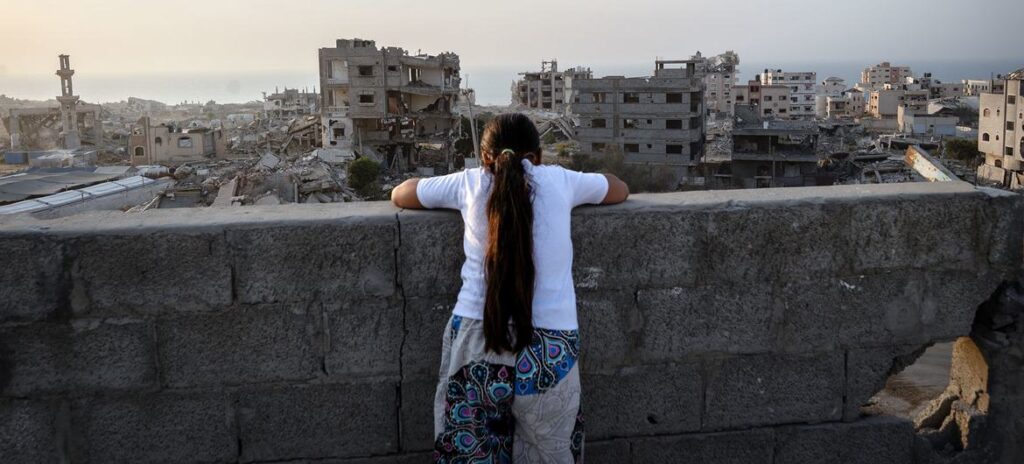Gaza: War (Genocide) Has Made Children Violent, Sad and Bereft
UNITED NATIONS, 17 Nov 2025
UN News - Human Wrongs Watch - TRANSCEND Media Service
More than nine in 10 children in Gaza are displaying signs of aggressive behaviour linked to more than two years of war between Hamas and Israel, welfare agencies have reported.
13 Nov 2025 – Issuing a warning that the children’s sense of stability and security has been eroded as key everyday services have collapsed, humanitarians insist that young Gazans will need “sustained, long-term efforts to recover.”
Violence every day
While a fragile ceasefire holds, the deadly violence and insecurity have not ended entirely, with Israeli military strikes near or east of the so-called “Yellow Line”.
This is where the Israeli military remains deployed, amounting to more than 50 per cent of the Gaza Strip, OCHA said.
In an update, the UN aid office noted that access to the sea remains prohibited; it also cited reports that Palestinian fishers continue to be detained at sea by Israeli forces.
“In areas beyond the ‘Yellow Line’…daily detonations of residential buildings continue to be reported and access to humanitarian assets, public infrastructure and agricultural land remains restricted or altogether barred,” the OCHA update states.
One million still homeless
Out of Gaza’s 2.1 million population, approximately a million live in 862 displacement sites today.
More than half of these sites are in the southernmost area of Khan Younis, 264 are in Deir al Balah, 180 are in Gaza and North Gaza governorates and eight are in Rafah.
Many camps are overcrowded, increasing the dangers for girls and children – particularly those with disabilities at risk from violence, neglect and dangerous access to water, sanitation and hygiene (WASH) facilities.
The UN Palestine relief agency, UNRWA, said that around 75,000 people are living in around 100 of its designated shelters and surrounding areas.
Rising anxiety
UN aid partners providing assistance to youngsters report that they suffer from heightened anxiety, behavioural changes and growing concern over the ongoing lack of safe spaces.
In the four weeks since an agreed pause in fighting, humanitarian partners have delivered child protection services to more than 132,000 across the Gaza Strip.
This includes nearly 1,600 children with disabilities and 45,000 caregivers, OCHA said.
Assistance has included individual psychological consultations, group sessions, stress management activities, recreational psychosocial support and referrals for further help.
The aim is to reach more than 100,000 children each month to address the needs of nearly one million children in the Gaza Strip.
The development came as the Israeli authorities announced the reopening of Zikim crossing following an eight-week closure.
The crossing links Israel and northern Gaza and will reopen for humanitarian cargo, OCHA said. In recent weeks, the UN has been repairing the road leading to Zikim inside Gaza in preparation for the reopening and is now carrying out final checks – including for potential explosive hazards – to enable the resumption of cargo collection.
Tags: Crimes against Humanity, Gaza, Genocide, IDF, Israel, Palestine, USA, United Nations, War crimes, Zionism
DISCLAIMER: The statements, views and opinions expressed in pieces republished here are solely those of the authors and do not necessarily represent those of TMS. In accordance with title 17 U.S.C. section 107, this material is distributed without profit to those who have expressed a prior interest in receiving the included information for research and educational purposes. TMS has no affiliation whatsoever with the originator of this article nor is TMS endorsed or sponsored by the originator. “GO TO ORIGINAL” links are provided as a convenience to our readers and allow for verification of authenticity. However, as originating pages are often updated by their originating host sites, the versions posted may not match the versions our readers view when clicking the “GO TO ORIGINAL” links. This site contains copyrighted material the use of which has not always been specifically authorized by the copyright owner. We are making such material available in our efforts to advance understanding of environmental, political, human rights, economic, democracy, scientific, and social justice issues, etc. We believe this constitutes a ‘fair use’ of any such copyrighted material as provided for in section 107 of the US Copyright Law. In accordance with Title 17 U.S.C. Section 107, the material on this site is distributed without profit to those who have expressed a prior interest in receiving the included information for research and educational purposes. For more information go to: http://www.law.cornell.edu/uscode/17/107.shtml. If you wish to use copyrighted material from this site for purposes of your own that go beyond ‘fair use’, you must obtain permission from the copyright owner.
Join the discussion!
We welcome debate and dissent, but personal — ad hominem — attacks (on authors, other users or any individual), abuse and defamatory language will not be tolerated. Nor will we tolerate attempts to deliberately disrupt discussions. We aim to maintain an inviting space to focus on intelligent interactions and debates.
